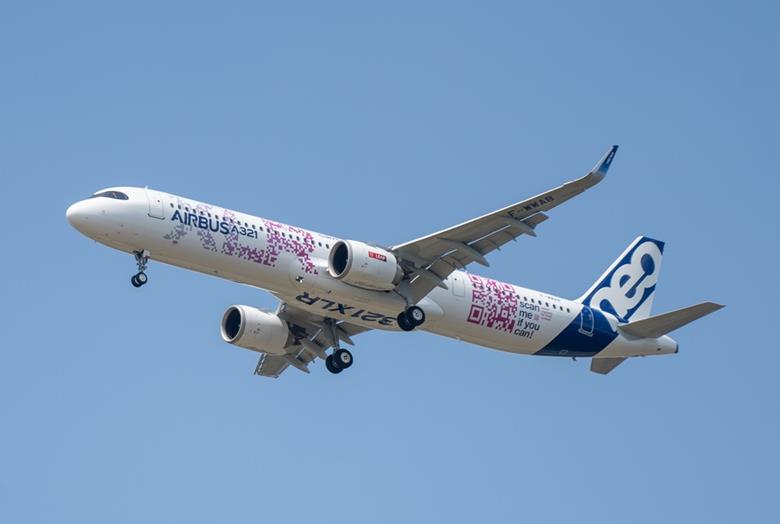A slight bump in the road for the Airbus A321XLR was announced as a part of the announcement of the OEM’s full-year results for 2023. The OEM, who wanted to put the first A321XLR into service in the second quarter of 2024, said the Entry into Service would be slightly delayed and go into the second half of 2024. More specifically, Airbus states that the EIS will be in Q3 2024.
Airbus A321XLR EIS delays
The Airbus A321XLR, of which IndiGo is a significant customer, will see a delayed entry into service. This will be the most extended range of narrow-body aircraft globally, allowing them to operate point-to-point flights that weren’t previously viable, with a range of up to 4,700 nautical miles. Airbus will achieve this by adding a new fuel tank in the aircraft’s rear, the Rear Center Tank (RCT). Usually, fuel is stored in the wings and centre of the plane (which also aids the aircraft balancing).
The most significant difference between the XLR, A321neo and A321LR is the Rear Center Tank (RCT), which is supposed to give the XLR its 4,700nm/8,700km range. The tank’s position is subject to special attention from the regulators, especially after Boeing expressed concerns about the fire protection of the tank, which is right under the cabin. EASA had previously stated that it would likely require extra measures to guarantee the tank’s safety in the event of a fire. This could include additional insulation that would increase the weight of the XLR, potentially affecting its unique selling point – its range. EASA is worried about the fire risk that comes into the picture from the extra fuel tank being added to the A321 aircraft and wants Airbus to work on reducing the risk.
The earlier plan was to have the aircraft enter service in late 2023. However, this has moved to 2024; now, it is a bit more into 2024. Airbus has indicated that approximately 550 of the 6,100 A321neo orders are for the XLR variant, a number previously not announced.
The aircraft still awaits type certification from EASA, the European civil aviation authority, and the FAA, the US agency.
Airbus is ramping up production.
Airbus is accumulating new orders, and in 2023, the gross commercial aircraft orders totalled 2,319 (2022: 1,078 aircraft), with net orders of 2,094 aircraft after cancellations (2022: 820 aircraft). The order backlog is now at 8,598 commercial aircraft at the end of 2023. In 2024, the airframe maker expects to deliver 800 aircraft. It delivered 735 aircraft in 2023, comprising 68 A220s, 571 A320 Family, 32 A330s and 64 A350s.
Airbus CEO Guillaume Faury has earlier talked about ramping up production, and this is going per plan now. Airbus wants to move to 75 A320 aircraft per month in 2026. The A220 ramp-up continues towards a monthly production rate of 14 aircraft in 2026.
In 2023, construction of the second A320 Final Assembly capacities in Tianjin (China) and Mobile (US) commenced, and the new A320 Family Final Assembly Line in Toulouse delivered its first aircraft in December.
On widebody aircraft, Airbus will continue towards a monthly rate of 4 aircraft for the A330 in 2024 and a rate of 10 in 2026 for the A350.
Bottomline
Airbus has announced a (slight) delay in the Entry into Service of the A321XLR. The A321XLR will now enter service in Q32024 instead of the last announced Q22024 (which was delayed from 2023 EIS). Airbus is further progressing well in making more aircraft per month to be able to deliver over 8,000 aircraft in its backlog.
What do you think of the delay in entry of the A321XLR and the overall plans of Airbus Commercial Airplanes?
Liked our articles and our efforts? Please pay an amount you are comfortable with; an amount you believe is the fair price for the content you have consumed. Please enter an amount in the box below and click on the button to pay; you can use Netbanking, Debit/Credit Cards, UPI, QR codes, or any Wallet to pay. Every contribution helps cover the cost of the content generated for your benefit.
(Important: to receive confirmation and details of your transaction, please enter a valid email address in the pop-up form that will appear after you click the ‘Pay Now’ button. For international transactions, use Paypal to process the transaction.)
We are not putting our articles behind any paywall where you are asked to pay before you read an article. We are asking you to pay after you have read the article if you are satisfied with the quality and our efforts.



Leave a Reply